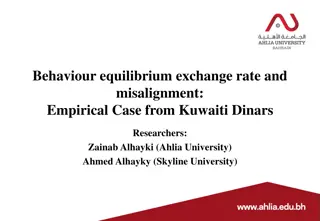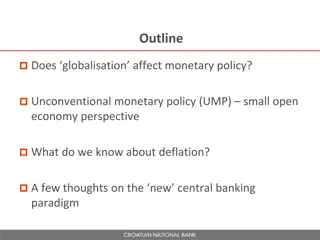Understanding the Effects of Monetary Policy on Exchange Rates
Explore the interconnected relationship between money supply, interest rates, and exchange rates in international economics. Learn how changes in domestic and foreign money supplies impact currency depreciation, appreciation, and interest rate fluctuations. Gain insights into the long-run effects of monetary policy on prices and exchange rates.
Uploaded on Oct 11, 2024 | 0 Views
Download Presentation

Please find below an Image/Link to download the presentation.
The content on the website is provided AS IS for your information and personal use only. It may not be sold, licensed, or shared on other websites without obtaining consent from the author. Download presentation by click this link. If you encounter any issues during the download, it is possible that the publisher has removed the file from their server.
E N D
Presentation Transcript
International Economics II Price level and the Exchange Rates 2 HE Educator : Dr. Waqar Ahmad
Learning Objectives A model of real monetary assets and interest rates A model of real monetary assets, interest rates, and exchange rates Long run effects of changes in money on prices, interest rates, and exchange rates
Fig 14-7: Money Market/Exchange Rate Linkages
Simultaneous Simultaneous Equilibrium in the U.S. Money Market and the Foreign Equilibrium in the U.S. Money Market and the Foreign Exchange Market Market
Effect Effect on the Dollar/Euro on the Dollar/Euro Exchange Rate and Exchange Rate and Dollar Interest Rate of an Increase in the U.S. Money Supply Interest Rate of an Increase in the U.S. Money Supply
Changes in the Domestic Money Supply An increase in a country s money supply causes interest rates to fall, rates of return on domestic currency deposits to fall, and the domestic currency to depreciate. A decrease in a country s money supply causes interest rates to rise, rates of return on domestic currency deposits to rise, and the domestic currency to appreciate.
Changes in the Foreign Money Supply How would a change in the supply of euros affect the U.S. money market and foreign exchange markets? An increase in the supply of euros causes a depreciation of the euro (appreciation of the dollar). A decrease in the supply of euros causes an appreciation of the euro (a depreciation of the dollar).
Effect of an Increase in the European Money Supply on the Dollar/Euro Exchange Rate
Changes in the Foreign Money Supply (cont.) The increase in the supply of euros reduces interest rates in the EU, reducing the expected rate of return on euro deposits. This reduction in the expected rate of return on euro deposits causes the euro to depreciate. We predict no change in the U.S. money market due to the change in the supply of euros.
Long Run and Short Run In the short run, prices do not have sufficient time to adjust to market conditions. the analysis heretofore has been a short run analysis. In the long run, prices of factors of production and of output have sufficient time to adjust to market conditions. Wages adjust to the demand and supply of labor. Real output and income are determined by the amount of workers and other factors of production by the economy s productive capacity not by the quantity of money supplied. (Real) interest rates depend on the supply of saved funds and the demand of saved funds.
Long Run and Short Run (cont.) In the long run, the quantity of money supplied is predicted not to influence the amount of output, (real) interest rates, and the aggregate demand of real monetary assets L(R,Y). However, the quantity of money supplied is predicted to make level of average prices adjust proportionally in the long run. The equilibrium condition Ms/P = L(R,Y) shows that P is predicted to adjust proportionally when Msadjusts because L(R,Y) does not change.
Long Run and Short Run (cont.) In the long run, there is a direct relationship between the inflation rate and changes in the money supply. Ms = P x L(R,Y) P = Ms/L(R,Y) P/P = Ms/Ms - L/L The inflation rate is predicted to equal the growth rate in money supply minus the growth rate in money demand.
Average Money Growth and Inflation in Western Hemisphere Developing Countries, by Year, 1987 2006 Source: IMF, World Economic Outlook, various issues. Regional aggregates are weighted by shares of dollar GDP in total regional dollar GDP.
Money and Prices in the Long Run How does a change in the money supply cause prices of output and inputs to change? 1. Excess demand of goods and services: a higher quantity of money supplied implies that people have more funds available to pay for goods and services. To meet high demand, producers hire more workers, creating a strong demand of labor services, or make existing employees work harder. Wages rise to attract more workers or to compensate workers for overtime. Prices of output will eventually rise to compensate for higher costs.
Money and Prices in the Long Run (cont.) Alternatively, for a fixed amount of output and inputs, producers can charge higher prices and still sell all of their output due to the high demand. 2. Inflationary expectations: If workers expect future prices to rise due to an expected money supply increase, they will want to be compensated. And if producers expect the same, they are more willing to raise wages. Producers will be able to match higher costs if they expect to raise prices. Result: expectations about inflation caused by an expected increase in the money supply causes actual inflation.
Money, Prices, Exchange Rates, and Expectations When we consider price changes in the long run, inflationary expectations will have an effect in foreign exchange markets. Suppose that expectations about inflation change as people change their minds, but actual adjustment of prices occurs afterwards.
Short-Run and Long-Run Effects of an Increase in the U.S. Money Supply (Given Real Output, Y) Change in expected return on euro deposits The expected return on euro deposits rises because of inflationary expectations: The dollar is expected to be less valuable when buying goods and services and less valuable when buying euros. The dollar is expected to depreciate, increasing the return on deposits in euros.
Short-Run and Long-Run Effects of an Increase in the U.S. Money Supply (Given Real Output, Y) Original (long run) return on dollar deposits As prices increase, the real money supply decreases and the domestic interest rate returns to its long run rate.
Money, Prices, and Exchange Rates in the Long Run (cont.) A permanent increase in a country s money supply causes a proportional long run depreciation of its currency. However, the dynamics of the model predict a large depreciation first and a smaller subsequent appreciation. A permanent decrease in a country s money supply causes a proportional long run appreciation of its currency. However, the dynamics of the model predict a large appreciation first and a smaller subsequent depreciation.
Time Paths of U.S. Economic Variables After a Permanent Increase in the U.S. Money Supply
Exchange Rate Overshooting The exchange rate is said to overshoot when its immediate response to a change is greater than its long run response. Overshooting is predicted to occur when monetary policy has an immediate effect on interest rates, but not on prices and (expected) inflation. Overshooting helps explain why exchange rates are so volatile.
Month-to-Month Variability of the Dollar/Yen Exchange Rate and of the U.S./Japan Price Level Ratio, 1974 2007 Changes in price levels are less volatile, suggesting that price levels change slowly. Exchange rates are influenced by interest rates and expectations, which may change rapidly, making exchange rates volatile. Source: International Monetary Fund, International Financial Statistics
Summary 1. Money demand for individuals and institutions is primarily determined by interest rates and the need for liquidity, the latter of which is influenced by prices and income. 2. Aggregate money demand is primarily determined by interest rates, the level of average prices, and national income. Aggregate demand of real monetary assets depends negatively on the interest rate and positively on real national income.
Summary (cont.) 3. When the money market is in equilibrium, there are no surpluses or shortages of monetary assets: the quantity of real monetary assets supplied matches the quantity of real monetary assets demanded. 4. Short run scenario: changes in the money supply affect domestic interest rates, as well as the exchange rate. An increase in the domestic money supply 1. lowers domestic interest rates, 2. lowering the rate of return on deposits of domestic currency, 3. causing the domestic currency to depreciate.
Summary (cont.) 5. Long run scenario: changes in the quantity of money supplied are matched by a proportional change in prices, and do not affect real income and real interest rates. An increase in the money supply 1. causes expectations about inflation to adjust, 2. causing the domestic currency to depreciate further, 3. and causes prices to adjust proportionally in the long run, 4. causing interest rates return to their long run values, 5. and causes a proportional long run depreciation in the domestic currency.
Summary (cont.) Interest rates adjust immediately to changes in monetary policy, but prices and (expected) inflation may adjust only in the long run, which results in overshooting of the exchange rate. Overshooting occurs when the immediate response of the exchange rate due to a change is greater than its long run response. Overshooting helps explain why exchange rates are so volatile.























